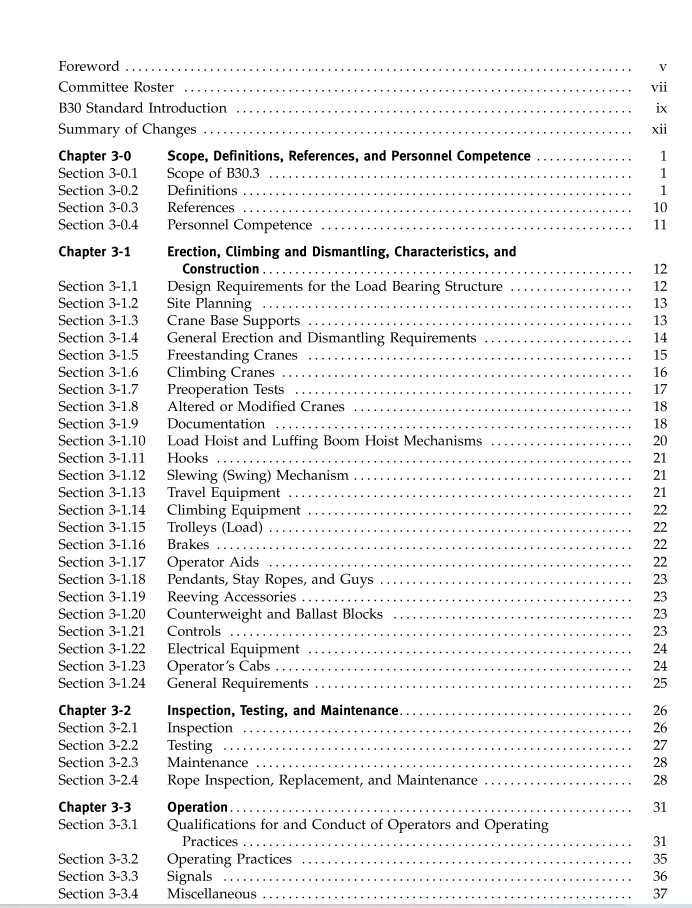ASME B30.3:2016 pdf download Tower Cranes Safety Standard for Cableways, Cranes, Derricks, Hoists, Hooks, Jacks, and Slings
control station: the location of the crane function controls,either cab mounted or by remote control.
counterjib: a horizontal member of a crane on which thecounterweights and usually the hoisting machinery aremounted.
counterzveight: weights added to a crane superstructureto create additional stability or to counter the effects ofthe lifted load; they rotate with the crane as it swings.crane: in this Volume, the use of the word crane refersto tower cranes, which are lifting machines consistingof a tower with a superstructure that rotates and includesa load,luffing boom, or jib,and, on some cranes,acounterjib extending in the opposite direction to theload, luffing boom, or jib.
crane, standby: a crane that is not in regular service butthat is used occasionally or intermittently as required.crossoOver points: points of rope contact where one layerof rope on a rope drum crosses over the previous layer.documentation: The organized collection of informationthat describes the structure, design, purpose, operation,maintenance, and safety requirements for the crane andincludes the stickers, placards, and labels that provideoperational or safety-related information.
dru: the cylindrical member around which rope iswound for lifting or lowering a load.
dynanic loading: loads introduced into the machine orits components by forces in motion.
equualizer: a device that compensates for unequal lengthor stretch of a rope.
flange point: the point of contact between the rope anddrum flange where the rope changes layers on a ropedrum.
freestanding height: that height of a crane which is sup-ported by the tower alone without assistance frombraces, guys, or other means.
gage,frack: the horizontal distance between two rails,measured perpendicular to the direction of travel.
guy rope: a fixed-length supporting rope intended tomaintain a nominally fixed distance between the twopoints of attachment; may also be called a stay rope,standing rope, or pendant (see Fig.3-0.2.1.2-2).
high strengfh bolts: high strength tensile bolts used in theassembly of crane sections. The bolts are installed in
tension, by torquing or other means, at a level greaterthan that produced by in- or out-of-service loads, forthe purpose of reducing the likelihood of bolt fatiguefailure.
is-service: the condition of a crane ready for or engagedin work; an operator is at the controls.
jsb: the horizontal structural member attached to therotating superstructure of a crane on which the loadtrolley travels wvhen changing load radius.
jib point: the outward end of the load-bearing jib.
iowifinsg device: a device that is operated by some partof a power-driven machine or equipment to restrictloads, or motions of the machine or equipment.
Iond: the total superimposed weight on the hook.
load block: the assembly of hook, swivel, sheaves, pins,and frame suspended by the hoisting rope.
Isuffing boom: a member hinged to the rotating superstruc-ture that raises and lowers to change load radius andis used for supporting the hoisting tackle.
lsuffing boom stop: a device used to limit the angle of theluffing boom at the highest recommended position.ornwal operatinrg condition: a condition during which acrane is performing functions within the manufacturer’soperating recommendations. Under these conditions,the operator is at the operating controls, and no personsother than those appointed are on the crane.
operafional aid: a device that provides information tofacilitate operation of a crane.Examples of such devicesinclude, but are not limited to, the following: luffingboom angle or hook radius indicator, trolley radius indi-cator, load moment indicator, and wind velocity device.ouet-of-service: the condition of a crane when unloaded,without powver, with the controls unattended , and pre-pared to endure winds above the in-service level.
ozertserning Ioiert: the summation of the individualmoments that add to the tipping tendency of a craneabout its fulcrum.
parking track: for rail-mounted cranes, a section of tracksupported so that it is capable of sustaining storm-induced bogie loads; it is provided with storm anchor-ages when requiredi.
pasil(dog): a device for positively holding a memberagainst motion in one or more directions.
poeriddart: a rope or bar of specified length with fixed endconnections.
pitch diamefer: the diameter of a sheave or rope drummeasured at the centerline of the rope.
quealifted person: a person who, by possession of a recog-nized degree in an applicable field or a certificate ofprofessional standing,or by extensive knowledge, train-ing.and experience, has successfully demonstrated the
ASME B30.3:2016 pdf download
